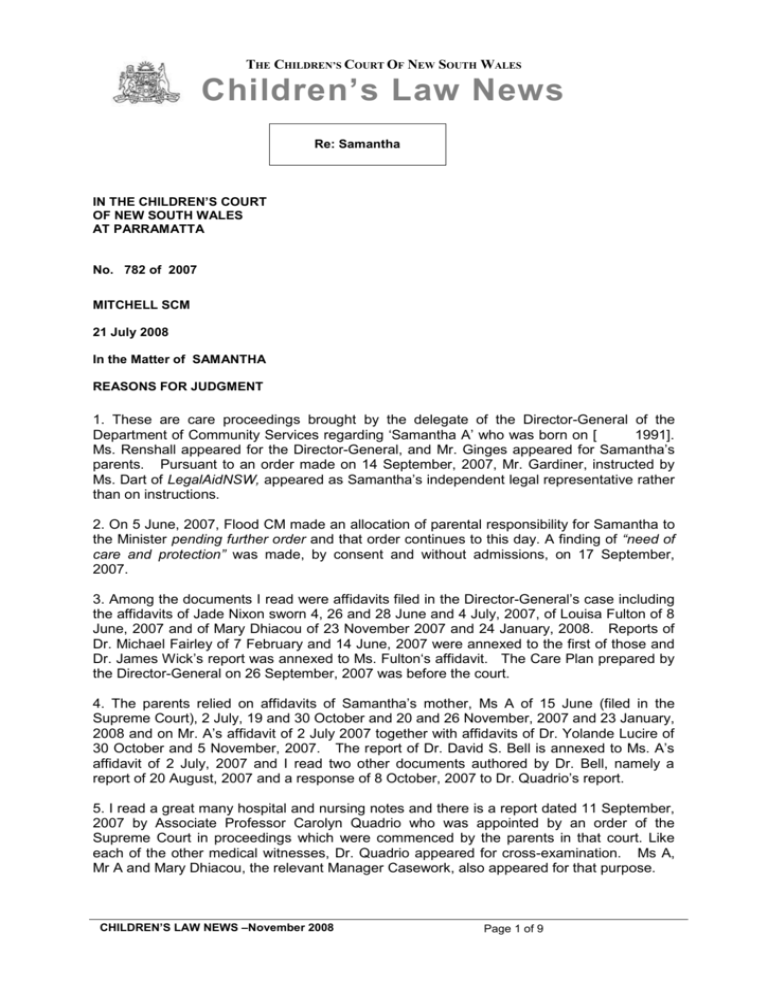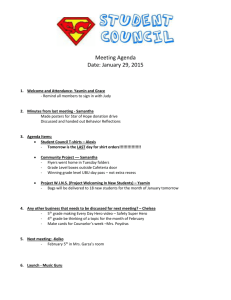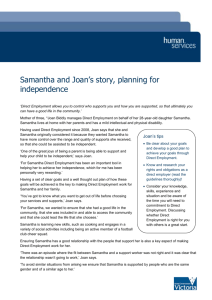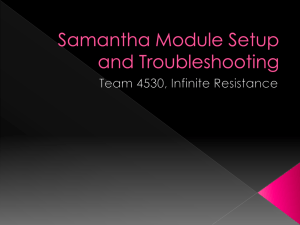Re – Samantha S - Children's Court Home
advertisement

THE CHILDREN’S COURT OF NEW SOUTH WALES Children’s Law News Re: Samantha IN THE CHILDREN’S COURT OF NEW SOUTH WALES AT PARRAMATTA No. 782 of 2007 MITCHELL SCM 21 July 2008 In the Matter of SAMANTHA REASONS FOR JUDGMENT 1. These are care proceedings brought by the delegate of the Director-General of the Department of Community Services regarding ‘Samantha A’ who was born on [ 1991]. Ms. Renshall appeared for the Director-General, and Mr. Ginges appeared for Samantha’s parents. Pursuant to an order made on 14 September, 2007, Mr. Gardiner, instructed by Ms. Dart of LegalAidNSW, appeared as Samantha’s independent legal representative rather than on instructions. 2. On 5 June, 2007, Flood CM made an allocation of parental responsibility for Samantha to the Minister pending further order and that order continues to this day. A finding of “need of care and protection” was made, by consent and without admissions, on 17 September, 2007. 3. Among the documents I read were affidavits filed in the Director-General’s case including the affidavits of Jade Nixon sworn 4, 26 and 28 June and 4 July, 2007, of Louisa Fulton of 8 June, 2007 and of Mary Dhiacou of 23 November 2007 and 24 January, 2008. Reports of Dr. Michael Fairley of 7 February and 14 June, 2007 were annexed to the first of those and Dr. James Wick’s report was annexed to Ms. Fulton‘s affidavit. The Care Plan prepared by the Director-General on 26 September, 2007 was before the court. 4. The parents relied on affidavits of Samantha’s mother, Ms A of 15 June (filed in the Supreme Court), 2 July, 19 and 30 October and 20 and 26 November, 2007 and 23 January, 2008 and on Mr. A’s affidavit of 2 July 2007 together with affidavits of Dr. Yolande Lucire of 30 October and 5 November, 2007. The report of Dr. David S. Bell is annexed to Ms. A’s affidavit of 2 July, 2007 and I read two other documents authored by Dr. Bell, namely a report of 20 August, 2007 and a response of 8 October, 2007 to Dr. Quadrio’s report. 5. I read a great many hospital and nursing notes and there is a report dated 11 September, 2007 by Associate Professor Carolyn Quadrio who was appointed by an order of the Supreme Court in proceedings which were commenced by the parents in that court. Like each of the other medical witnesses, Dr. Quadrio appeared for cross-examination. Ms A, Mr A and Mary Dhiacou, the relevant Manager Casework, also appeared for that purpose. CHILDREN’S LAW NEWS –November 2008 Page 1 of 9 - 1 - of 9 THE CHILDREN’S COURT OF NEW SOUTH WALES Children’s Law News 6. Samantha, now seventeen years of age, is the daughter of Ms A and Mr A. She was brain damaged as a result of birth complications and she suffered from epilepsy. Her parents sought early advice as to her care and Samantha’s epilepsy was controlled by medication so that, with carefully monitored medication, she was able to attend school and live a normal life. She has lived with her family throughout most of her life but, in August, 2003, December, 2004 and January, 2005 she underwent short term admissions to Sydney Children’s Hospital at Randwick. In early 2007, Samantha experienced an apparently serious psychotic episode and was admitted to the psychiatric unit of the Sydney Children’s Hospital at Randwick. The records indicate that Samantha had displayed disordered thought patterns and sexually uninhibited behaviours such as stripping, attempting to run into the street naked, masturbation, sexually uninhibited talk and bizarre gestures. She was started on anti-psychotic medication including Olanzapine and was settled and allowed return home. Soon after, her symptoms returned and she was taken to hospital. From February to May, 2007, Samantha was an in-patient at Redbank House when she was sometimes in acute distress, “unable to maintain basic self-care skills, throwing furniture and hurting herself by punching and slapping herself.” In about May, 2007, Samantha appeared before the Mental Health Review Tribunal which placed her on a Community Treatment Order for a period of six months and she was discharged into the care of her parents. 7. Samantha appears to have been in trouble by the end of May, 2007 and on 29 May found her way to Sydney Children’s Hospital after police found her in a distressed state at a local shopping centre. Although she had given police to understand that she felt unable to return home, she did so when Ms. A visited her at the hospital and accompanied her home. But on 31 May, Samantha again attended Sydney Children’s Hospital, stating that she did not want to live with her family or indeed have contact with them and, on that occasion, she was admitted and remained at Sydney Children’s Hospital until 26 June, 2007. 8. Having, as the hospital the saw it, responded to treatment, Samantha was transferred to Stepping Stone House which is described in the plan as “a refuge setting for young adolescents with mental health issues whose goals include independent living” but that placement failed almost immediately when, it is reported, Samantha presented as “a physical threat to herself, other residents and staff” and she was immediately transferred and admitted to Missenden House which is the psychiatric unit of the Royal Prince Alfred Hospital at Camperdown. There she remained, apart from an unsuccessful 19 day period at a facility at Campbelltown, until 24 October, 2007 when, in terms of an order of the Mental Health Review Tribunal, she was discharged from RPA and commenced a placement with Guardian Youth Care. 9. According to the Director-General, the purpose of the placement with GYC was a gradual transition of Samantha to independence in the community. The placement was not successful and it is reported that on 9 December, 2007, Samantha attempted to self-harm and her mental health significantly deteriorated and, on 20 December, 2007, she was admitted to the acute adolescent unit at Redbank House where she remained until 12 March, 2008. 10. Samantha then returned to the GYC placement and the Director-General’s proposal, contained in the amended Care Plan of 30 April, 2008 is that she be in the parental responsibility of the Minister until she shall have attained the age of eighteen years so as to ensure that she remains there, supported by Quovus which has been retained by the Director-General to provide behaviour management support and on-going training for GYS staff involved in her care. CHILDREN’S LAW NEWS –November 2008 Page 2 of 9 - 2 - of 9 THE CHILDREN’S COURT OF NEW SOUTH WALES Children’s Law News 11. GYC offers a safe out-of-home placement for Samantha where she will have the Bryceefit of intensive support by trained staff and close supervision. According to the amended Care Plan, Samantha will have help with her personal and social development including “assistance with social skills, problem solving, budgeting, personal care and healthy living” Wisely, given her age, attention is being paid to “investigating vocational opportunities” and to a referral to the Department of Ageing, Disability and Home Care of which Samantha might be in need once she turns eighteen years of age and is too old for care. Further, as the Amended Care Plan points out, “there will be some consideration closer to Samantha’s 18 birthday as to whether it is appropriate to refer her to the Guardianship Tribunal to apply for a legal guardian.” Should she remain in the parental responsibility of the Minister, the proposal of the Director-General is that there should be no change in the general outline of her medical care which would continue to be administered by her present medical advisors or others who might come after them and are likely to subscribe to the same medical philosophies as guide her present carers. It seems to me that the Director-General has appropriately and adequately addressed permanency planning. 12. All of this is opposed by Mr. and Ms. A who disagree with the cure and with the complaint and they passionately dispute the Director-General’s view of their daughter’s medical condition and her recommendations for its continuation. They believe that the treatment to which Samantha has been subjected has significantly damaged her. They point to her persistent ill health as a sign of mistaken treatment. They oppose an allocation of parental responsibility to the Minister and believe that Samantha should return to their care without delay. Their intention is to engage Dr. Lowe as her general medical practitioner and Dr. Yolande Lucire in conjunction with Dr. David S. Bell as her consultant psychiatrists. Should their advice be that it is not viable for Samantha to return home immediately, Mr. and Ms. A would seek to negotiate a continuation of Samantha’s placement with Guardian Youth Care or perhaps an admission to a particular private hospital in Perth until her return home might more easily be undertaken but there can be little doubt that the parents are impatient for her return. Implicit in these proposals is the withdrawal of Samantha from the medical regime which has been put in place for her by Drs. Fairley and Wickramasuriya. It seems to me that, during the course of the hearing, the parents’ attitude as to the speed with which antipsychotic medications should be withdrawn may have changed but I think that, consistent with her belief that Samantha is being poisoned, withdrawal is seen by the Mother, in particular, as a very high priority. Indeed, after all this time, Ms. A appears unconvinced that Samantha is in need of any medication at all. She appears very much influenced by Dr. Lucire and accepting of her proposals. 13. Medical evidence was offered by Dr. Fairley, Dr. Wickramasuriya, Associate Professor Carolyn Quadrio, Dr. Bell and Dr. Lucire. All five took part in a conference of experts arranged by the court when a list of questions was submitted for their responses and each appeared at court when they were examined together. Drs. Fairley and Wickramasuriya (who is happy to be called Dr. Wick) were witnesses in the Director-General’s case. Dr Fairley is the Senior Staff Specialist and Consultant Psychiatrist in the Department of Child and Adolescent Psychiatry at the Children’s Hospital at Randwick and, for a long time, has been principally responsibly responsible for the direction of Samantha’s medical treatment. He is an extremely eminent practitioner and a leader in his field and he has the confidence of the Director-General and of those who might be called mainstream practitioners in New South Wales. Dr. Wick is the unit head and Medical Superintendent of the Acute Adolescent Unit at Redbank House where Samantha was a patient during 2007 and where she was placed at the time of the hearing. CHILDREN’S LAW NEWS –November 2008 Page 3 of 9 - 3 - of 9 THE CHILDREN’S COURT OF NEW SOUTH WALES Children’s Law News 14. Dr. Yolande Lucire is a provisionally registered consultant psychiatrist practicing forensic and medico-legal psychiatry at the Akathisia Clinic at Edgecliff. She is the principal medical witness in the parents’ case and she has never met Samantha. She has undertaken very little clinical work in the last few years and has devoted herself to a campaign regarding chronic neurotoxic conditions induced, she believes, by prescribed anti-psychotic medication. She has recently been reprimanded by the Professional Standards Committee of the New South Wales Medical Registration Board so outspoken has been her advocacy of her particular point of view and some of her literary output in defence of her point of view has appeared anything but sober and considered. She does not shrink from being described as an advocate of what, within her profession, remains a minority viewpoint. 15. Dr. David S. Bell, also called in the parents’ case, is an extremely highly qualified psychiatrist being a fellow of both the Royal Australian and New Zealand College of Physicians and the Royal Australian and New Zealand College of Psychiatrists. Like Dr. Lucire, he has never met Samantha but he proved a highly skilled and very articulate critic of the conventional views presented by Dr. Fairley and Dr. Wick. 16. In her submissions, Ms. Renshall summarised Dr. Fairley’s diagnosis that Samantha suffers from a psychotic illness, probably schizophrenia or schizoaffective disorder. Dr. Wick agrees that Samantha has a mental illness. His working diagnosis has been “a psychotic disorder with prominent mood symptoms with the differential that must be one of schizophrenic disorder or bipolar disorder.” In contrast, Dr. Lucire, supported by Dr. Bell, believes that Samantha is suffering from drug toxicity caused by antipsychotic medication, in particular Olanzapine, which has been prescribed for her, from akathisia and from neuroleptic malignant syndrome. According to Dr. Lucire, Samantha was in good health, despite brain injury and her epilepsy, with no sign of schizophrenia and with her epilepsy under control until 2003. Then she was withdrawn from Tegretol which had been effective in controlling the symptoms of her epilepsy and commenced on Olanzapine. Dr. Lucire told the court that it was then that Samantha developed “absolutely classic violent akathisia.” Symptoms of akathisia often include sexual cravings, desire for nicotine, behavioural discontrol and hallucinations and these, Dr. Lucire contends, prompted a mistaken diagnosis of schizophrenia. Since then, Dr. Lucire believes, the medication prescribed to treat a psychotic illness has poisoned and continues to poison Samantha and she advocates a speedy withdrawal. She would prefer to manage Samantha without antipsychotic medication. 17. Dr. Bell does not go quite as far as Dr. Lucire in that he does not deny the possibility that Samantha suffers a psychotic illness but argues, rather, that it is not possible to tell whether she does or does not, whether she is suffering from schizophrenia, as Dr. Fairley believes, or from a condition originating in epilepsy-induced brain damage perhaps exacerbated by her anti-psychotic medication. So, in order to make a reliable diagnosis, Dr. Bell advocates a careful and controlled reduction and perhaps even withdrawal of Samantha’s present medication which Dr. Fairley and Dr. Wick would be reluctant to do. 18. The four medical witness together with Professor Quadrio were examined individually and together and I came to the conclusion that I should prefer the more conventional approach of Drs. Fairley and Wick. The reasons I took that view are the following. Firstly, I think it is significant that Dr. Fairley and Dr Wick have each had “hands on” experience of Samantha’s condition. They know her and they have treated her and they have been and continue to be responsible for her welfare. They must have a more thorough and detailed appreciation of her plight than Drs. Lucire and Bell. Secondly, Dr. Lucire’s approach to this CHILDREN’S LAW NEWS –November 2008 Page 4 of 9 - 4 - of 9 THE CHILDREN’S COURT OF NEW SOUTH WALES Children’s Law News matter is the approach of a partisan and an advocate. She has developed a particular theory which she is keen to broadcast and establish and for which she has been fighting for a long time. This has become a campaign to which Dr. Lucire has devoted a great deal of her time and energy. It must be very difficult for a person in such a position critically to view a case which, at first sight, seems to favour one’s theory and Dr. Lucire’s demeanour while giving her evidence, the tone of much of her written material and the findings of Professional Standards Committee suggest that she may be less than objective in viewing Samantha’s case. 19. Thirdly, I found Dr. Wick a particularly impressive witness who, while respectful of senior colleagues, displayed a very thoughtful and steady approach to his patient’s care and a sensitivity to the professional views of his colleagues. 20. Fourthly, it seems significant to me that Dr. Lucire and perhaps Dr. Bell appear prepared to endorse the parents’ plan to withdraw Samantha’s current medical regime and radically change the complexion of her future medical care without closely and sufficiently considering how this might safely be done. In cross-examination, Ms. A told Ms. Renshall that, in her care, Samantha would either be sent to the Brycetley Private Hospital in Western Australia or be cared for at home. As Professor Quadrio pointed out in her report, it is not clear how Samantha could be transported to Western Australia in her present state of health or how she could be admitted to a facility in another state without her consent – a consent which Professor Quadrio believes, she is not able to give. Ms. A’s preference was that Samantha come home “for some nights” or permanently and then, at some time in the future should it be necessary, be admitted to Brycetley Hospital for a slow, closely monitored withdrawal from her present medication. Ms. A added, however, that she would prefer that Samantha withdraw while at home. 21. Ms. A’s plan envisages Samantha being at home and being cared for by her parents, her seventeen year old brother, ‘Nigel’, with whom she has never previously lived, her fifteen year old sister and, from time to time, her maternal grandmother. When it was suggested to her that Samantha’s care might require additional resources, Ms. A told the court that she might have recourse to “Dial an Angel” or “Silver Circle” although she was not aware whether their operatives were qualified as nurses. Samantha is a young person who requires very close monitoring and highly professional nursing care and my impression is that the parents’ plan for her care, apart from the withdrawal of the present medication, has barely been thought out. There is little indication of any prudent influence of Dr. Bell and/or Dr. Lucire in the parents’ planning to date. 22. Finally, the views of Dr. Fairley and Dr. Wick were generally endorsed by Professor Quadrio who enjoyed the independence of being the court’s own witness. She read all the medical evidence, took part in the conference of experts and heard their views and their evidence. Her report is very detailed and thorough and in it she concludes that “while high doses of neuroleptics may not be optimal, it is my opinion that the greater danger to Samantha arises from her longstanding and very serious behaviour disturbances; these place her at serious risk of harm – for example in terms of violent, sexual and suicidal or selfharm acting out, all of which she has manifested at times, including recently setting herself alight. It is my view that these behaviours are not manifestations of akathisia.” 23. Professor Quadrio’s view is that Samantha does not have akathisia and she pointed out in her report that, in her opinion, the symptoms for that condition are absent and, further, that “the parents’ concerns on this issue have been taken seriously and staff at Redbank regularly reviewed this by means of appropriate testing.” So far as Neuromalignant CHILDREN’S LAW NEWS –November 2008 Page 5 of 9 - 5 - of 9 THE CHILDREN’S COURT OF NEW SOUTH WALES Children’s Law News Syndrome is concerned, again Professor Quadrio’s opinion is that Samantha does not suffer from this condition and, again, she noted that the symptoms are absent and that the Redbank staff confirmed her view by making “appropriate assessments, investigations and consultations.” 24. Professor Quadrio maintained the view she expressed in her report that “it would be reasonable to aim for a reduction in the dose of Olanzapine as soon as possible” to be substituted by alternative antipsychotic medications and Dr Wick indicated that he is sympathetic to that view and is keen to be in a position where that adjustment can safely be undertaken. Professor Quadrio went on to report, though, that although drugs such as Olanzapine and Risperdal “are drugs with potentially serious side effects and are to be used with caution in children and adolescents and reserved for illnesses which are clearly psychotic, they are not specifically contraindicated in young persons and they are standard treatment for psychotic disturbances.” She pointed out that “in the case of Samantha, these medications have been prescribed by specialist psychiatrists with considerable experience” and that “it is apparent that over her three months period at Redbank House, Samantha settled on this and other medications and was discharged with no evidence of drug toxicity. Staff at Redbank took appropriate precautions with respect to the concerns of toxicity raised by the parents – they ordered blood tests and assessed involuntary movements and akathisia and they sought second opinions from psychiatrists, neurologists and from a psychopharmacological expert.” 25. While Professor Quadrio is prepared to agree “that a gradual switch to the use of more conventional antipsychotics might be possible (my emphasis),” she goes on to say that “to manage Samantha without any antipsychotic medication while she continues to manifest psychotic symptoms would be a dangerous course of action. If psychotic illness is worsened when episodes are untreated, the psychotic episode itself has a damaging effect on the patient’s mental condition.” 26. For those reasons, I think it more likely than not that the treatment offered Samantha by Dr. Fairley and Dr. Wick and their colleagues is to be preferred but this is not a case where well informed persons of good will might not reasonably hold a contrary view and Mr. and Ms. A certainly do. As parents, they have sought and are seeking to do what they believe is best for their daughter. They have been the subject of criticism by some who do not agree with them but, it seems to me that no useful purpose can be served reciting those criticisms here and that, throughout, they and Ms A in particular have been motivated by distrust of a medical regime which they believe is doing damage to Samantha. Unlike so many care cases, this is not a case in which parents are neglectful or deliberately abusive of their child. Absent the parents’ refusal to accept the medical regime which has been put in place, it is not clear that a finding of “need of care and protection” would or could have been made with regard Samantha and, in the context where the proposals of the parents cannot be dismissed as perverse and where there is honest disagreement as to what is best for Samantha, it might be thought that the state should defer to the view of the parents. I think, however, that such is not the case. 27. As Lord Oliver of Aylmerton observed in Re K.D. (A Minor) [1988] 1 AC 806, 824-5, “Parenthood, in most civilised societies, is generally conceived of as conferring upon parents the exclusive privilege of ordering, within the family, the upbringing of children of tender age, with all that that entails. That is a privilege which, interfered with without authority, would be protected by the courts, but it is a privilege circumscribed by many limitations imposed both by the general law and, where circumstances demand, by the courts or by the authorities upon whom the legislature has imposed the duty of supervising the welfare of children and CHILDREN’S LAW NEWS –November 2008 Page 6 of 9 - 6 - of 9 THE CHILDREN’S COURT OF NEW SOUTH WALES Children’s Law News young persons. When the jurisdiction of the court is invoked for the protection of the child the parental privileges do not terminate. They do, however, become immediately subservient to the paramount consideration which the court has always in mind, that is to say, the welfare of the child.” 28. In Re Z (A Minor) [1997] Fam. 1, 32, Bingham MR approached the role of unimpeachable parents by accepting “without reservation that the decision of a devoted and responsible parent should be treated with respect. It should certainly not be disregarded or lightly set aside. But the role of the court is to exercise an independent and objective judgment. If that judgment is in accord with that of the devoted and responsible parent, well and good. If it is not, then it is the duty of the court, after giving due weight to the view of the devoted and responsible parent, to give effect to its own judgment. That is what it is there for. Its judgment may of course be wrong. So may that of the parent. But once the jurisdiction of the court is invoked its clear duty is to reach and give the best judgment that it can.” 29. In his judgment in A (Children) [2000] EWCA Civ 254, well known as the “conjoined twins case,” Ward LJ. cited with approval the observation of Waite LJ in Re T (Wardship: Medical Treatment) [1997] 1 WLR 242 that “ An appraisal of parental reasonableness may be appropriate in other areas of family law (in adoption, for example where it is enjoined by statute) but when it comes to an assessment of the demands of the child patient’s welfare, the starting point – and the finishing point too – must always be the judge’s own independent assessment of the balance of advantage or disadvantage of the particular medical step under consideration. In striking that balance, the court will of course take into account as a relevant, often highly relevant, factor the attitude taken by the natural parent, and that may require examination of his or her motives. But the result of such enquiry must never be allowed to prove determinative. It is a mistake to view the issue as one in which the clinical advice of doctors is placed in one scale and the reasonableness of the parents view in the other.” Ward LJ spoke of “a scale, at one end of which lies the clear case where parental opposition to medical intervention is prompted by scruple or dogma of a kind which is patently irreconcilable with principles of child health and welfare widely accepted by the generality of mankind; and that at the other end lie highly problematic cases where there is genuine scope for a difference of view between the parent and the judge. In both situations it is the duty of the judge to allow the court’s own opinion to prevail in the perceived paramount interest of the child concerned…” 30. Accordingly, it seems to me that it is for the court to decide where Samantha’s best interests lie taking into account as a very important but not deciding factor the views and opinions of Mr. and Ms. A. 31. The court must also consider and take into account as best it can the views and wishes of Samantha herself. On 10 June, 2008 Ms. Dart filed a Statement of Views/Wishes which outlined Samantha’s position as at 11 September, 2007 when Professor Quadrio made her report, 13 June and 5 July, 2007, 25 January and 14 April, 2008. On 11 September, 2007 Dr. Quadrio reported that “Samantha’s psychiatric status is so complex and her current mental status is so fragile that she has limited capacity for understanding the issues or for making a decision in her own best interests. In my view her welfare is best represented at this time by the Director-General of the Department of Community Services. Further, for these reasons, Samantha is not able to instruct counsel in a meaningful way; she cannot appreciate the complexity of her situation and she cannot maintain a particular view.” CHILDREN’S LAW NEWS –November 2008 Page 7 of 9 - 7 - of 9 THE CHILDREN’S COURT OF NEW SOUTH WALES Children’s Law News 32. On 13 June, 2007, Ms. Dart received instructions from Samantha that “she agreed to continue the CTO under which she had been placed and opposed the alternate treatment/s being proposed by her parents” and that “she wished to return home as she was not allowed smoke cigarettes while in hospital.” These instructions were given during Samantha’s first meeting with Ms. Dart and apparently while Samantha was less than attentive to what was going on around her. Then, in a telephone interview on 20 June, 2007, Samantha told Ms. Dart that she wished to go home “on a trial basis” but “was content” to remain in hospital, was “willing” to go to Stepping Stone House and “did not care what happens.” 33. On 5 July, 2007, Ms. Dart made contact with Samantha after being informed by Ms. A that the child wanted to speak to her. According to Ms. Dart, Samantha said that she did not recall wanting to speak to her solicitor and could not recall what she may have wanted to tell her. In answer to questions, she told Ms. Dart that she was content to remain in hospital and that contact with Ms. A was progressing well. Samantha sought no change in the contact arrangements except to be reassured that she was allowed see her father. 34. Ms. Dart next saw Samantha on 25 January, 2008 while she was an involuntary patient at Redbank House. On that occasion, she told Ms. Dart that she enjoyed her placement with Guardian Youth Care and wanted to return there upon her discharge. At one point she told Ms. Dart that contact with her parents had been “OK” and then, later, said that she did not wish to see them. Given that Samantha could not recall having previously met Ms. Dart on what was their fourth discussion, it is not clear Samantha was in a proper state to express any views or wishes on that day. 35. Finally, on 14 April, 2008, when Ms. Dart visited Samantha at her GYC placement, Samantha said she wanted to go home but shrugged and expressed no preference when asked about her wishes as to frequency of contact with her family in the event that she remains in out of home care and in the parental responsibility of the Minister. 36. It seems to me that, although she is sometimes ambivalent and changes her mind from time to time, Samantha’s preference, in common with most young persons who find themselves in care, is to return home. On the other hand, despite her advanced age which would normally lend a great deal of weight to her views and wishes, I think Samantha may have a diminished capacity to express a well considered preference as to her future. I can place only limited weight on her views and wishes. 37. So deep is the division between Mr. and Ms. A and the Director-General’s officers charged with Samantha’s care and so lacking in trust and so passionate is the parents’ belief that Samantha’s therapy is inappropriate and harmful that they could not reasonably be expected to co-operate successfully in the event that parental responsibility for Samantha were reallocated to the parents. For those reasons, I have come to the conclusion that there is no realistic possibility of restoration and that Samantha’s safety, welfare and wellbeing require that she remain in the parental responsibility of the Minister until she shall have attained the age of 18 years and I would order accordingly. 38. Addressing the question of contact, it is important to keep in mind that Samantha is not a child but is a young person of seventeen years of age and, when in good health, should be entitled to decide those matters for herself. The difficulty is that her health is precarious at best and her parents are so strongly committed to their view of what is best for her and so strongly opposed to the Director-General’s attitudes in that regard that their discretion cannot be assured. The evidence discloses that there may have been occasions when Ms. A’s CHILDREN’S LAW NEWS –November 2008 Page 8 of 9 - 8 - of 9 THE CHILDREN’S COURT OF NEW SOUTH WALES Children’s Law News comments have been less than helpful to Samantha. Accordingly and depending on Samantha’s state of health at the time, there may be occasions when contact should be supervised although there will surely be times when supervision will be unnecessary. Equally, there may be times when, for good reasons or ill, Samantha will choose not to have contact with her parents and her wishes and needs in that regard should be respected. By the same token, when she wants contact to her parents then, provided she is well, she should be allowed have it. 39. So complicated are Samantha’s contact needs and so likely are they to change from time to time that, presently, it is not viable to make an order under section 86. It would be preferable to leave the Minister and the parents to make arrangements for contact which are appropriate from time to time and the expectation of the court is that this is what will happen. The orders as to the allocation of parental responsibility which the court proposes to make are predicated upon contact being made available when appropriate. Should that not happen, the way will be open to any aggrieved party to seek leave under section 90(1) and, if leave be granted, bring such application under section 90(7) as might then appear appropriate. 40. Accordingly the order of the court is that parental responsibility for the young person Samantha A, born [ 1991], be allocated to the Minister until Samantha shall have attained the age of eighteen years. The applications are otherwise dismissed. Copyright 2008 Crown Copyright All material is reproduced by permission of the Crown but does not purport to be the official or authorised version. Downloading, copying or printing of materials in this database for personal use, or on behalf of another person, is permitted. Downloading, copying or printing of material from this database for the purpose of reproduction or publication (in whole or in part) for a fee is not permitted without express authorisation. CHILDREN’S LAW NEWS –November 2008 Page 9 of 9 - 9 - of 9






